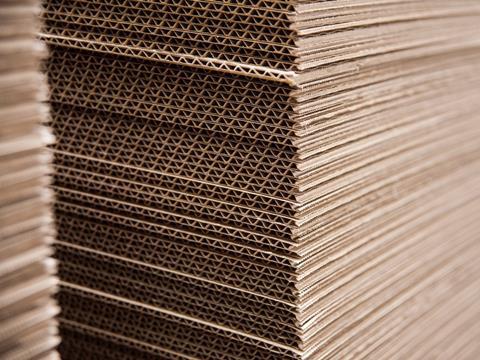
The European Federation of Corrugated Board Manufacturers (FEFCO), which represents the corrugated packaging industry across Europe, has today released its Corrugated Packaging Recyclability Guidelines aimed at optimising recyclability via design parameters for paper and board packaging.
Developed with The Confederation of Paper Industries (CPI), the guidelines seek to provide the corrguated industry with a practical set of tools to contribute to the optimal use of natural resources while minimising environmental impact. The guidelines are aimed at brands, retailers, and corrugated companies – rather than the general public – to aid the design of packaging.
FEFCO claims that over 83% of paper and board is already recycled in the EU, while corrugated packaging reportedly has an 89% recycled content average.
However, while FEFCO insists that paper and board are sustainable and renewable materials for packaging, the actual recyclability of packaging products is determined by composition and design, and the way in which packaging is collected, sorted, and presented for reprocessing.
For example, the FEFCO guidelines identify the addition of plastic to corrugated packaging as having a negative impact on reprocessing and companies’ economic margins. FEFCO says that the industry would prefer to avoid all plastics, even biodegradable varieties. It provides the design metric of keeping plastic content to 5% of pack weight as a maximum, with a 3% weight content being the preferred amount.
The guidelines acknowledge that plastic will sometimes be used and suggest types of plastic that are more problematic than others and should thus be avoided. This includes polymers with low shear strength, which can break down in the pulper and contaminate the finished product, or plastics with the same density as fibre, as these are apparently not separated by hydro cleaners used in paper mills.
FEFCO adds that the industry would prefer for laminated paper material to be collected separately and sold as a discrete grade to mills with specialist facilities to reprocess it effectively. Some mills, FEFCO notes, can reprocess laminated products when presented in baled form, but most “standard” mills will dispose of it in waste streams.
While not aimed at the consumer, the guidelines emphasise the importance of designs that allow easy separation of the laminate from the board and that clearly encourage the consumer to do this before placing the packaging into recycling streams. As such, peelable liners are named as the industry preference, especially as they can help to reduce food contamination.
According to the guidelines, some film coatings added to packaging, such as single-sided laminates or metallicized films, do not interfere as much with the separation of fibre depending on the degree of adhesion, although the requirement to separate these can allegedly add costs.
It does, however, warn that small metallic particles can interfere with the equipment used to measure flows in paper mills. Overall, FEFCO adds that – like plastics – it would prefer not to receive metallised or plastic laminated board.
As for adhesives, the report suggests that the industry favours types that do not plasticise at temperatures above 35oC, which is the typical pulper temperature. The preference is therefore for cold set, curable, or water-soluble adhesives, rather than hot melt adhesives.
When identifying their impact of varnishes on the recycling process, FEFCO says that UV varnishes can cause issues as they are not always removed by conventional de-inking technologies. Again, it reaches the verdict that these materials should be avoided. It does add that coatings that are soluble in water can generally be treated in paper mills, so are acceptable for the industry.
According to FEFCO’s report, fillers and binders – which are added to paper and board to provide enhanced surface qualities and improve printability – do provide some challenges, but are normal constituents of the papermaking process, meaning they can be dealt with by paper mills.
FEFCO further claims that most paper mills are set up to reprocess cellulose fibre derived from trees. It acknowledges that the industry is under pressure to develop alternatives to fibres derived from trees, but that these alternatives still require research to assess their suitability.
Similarly, while FEFCO notes that the industry supports research to develop alternative barrier technologies, it says it cannot yet judge the recyclability of these technologies, partially due to Intellectual Property considerations.
FEFCO concludes that it is not feasible or practical for the industry to evaluate the recyclability of individual packaging products on a case-by-case basis. Responding to this challenge, it intends for the Corrugated Packaging Recyclability Guidelines to provide design parameters that, if adhered to, can standardise and optimise the recyclability of paper-based packaging across the supply chain.
















